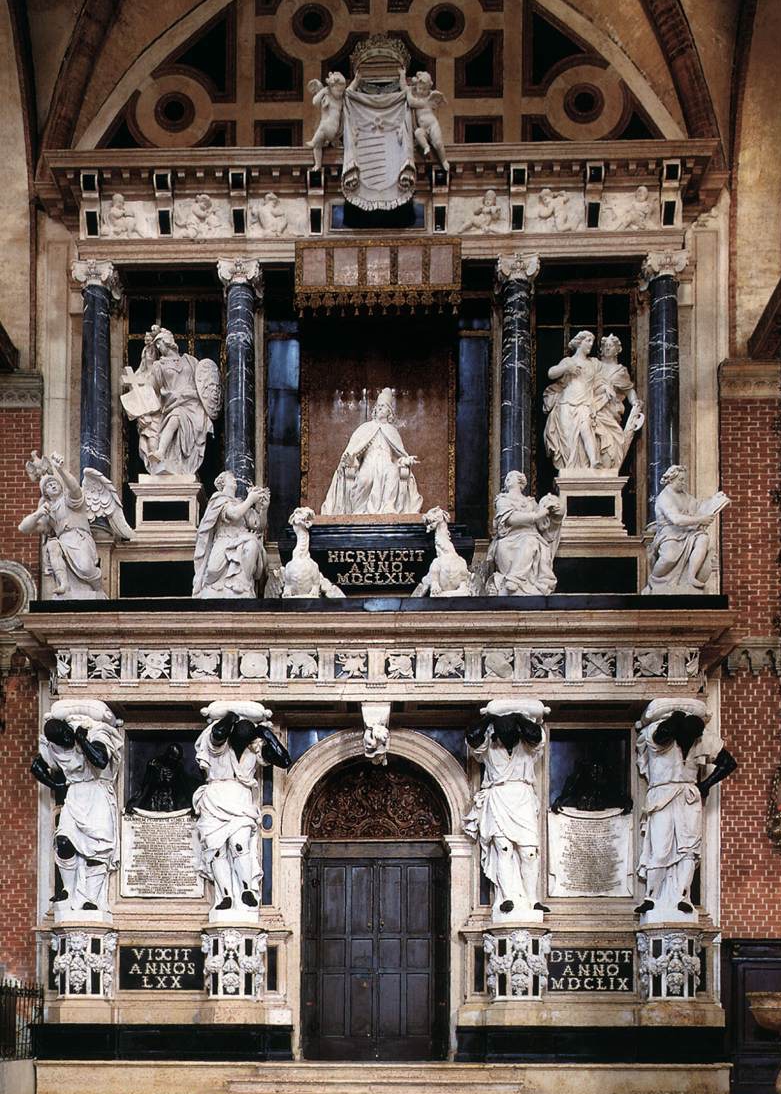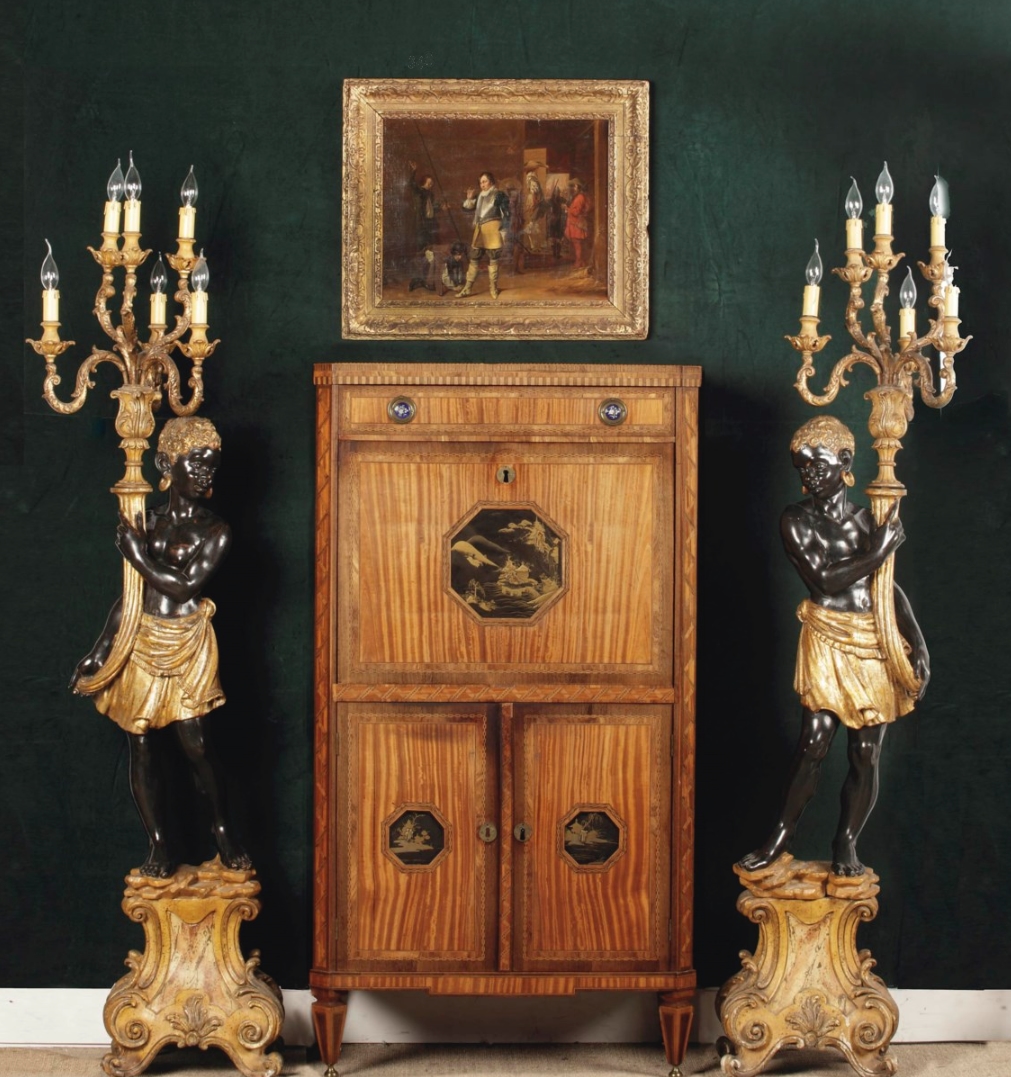Scene 2:
Enter Wilson
Wilson was aware of the “Blackamoor” and explored its presence in the Venice Biennale. Before even setting foot into his exhibition, the viewer was greeted by Wilson’s banners [Fig. 15] of the atlantes of Baldassare Longhena’s (1598-1682) Monument to Doge Giovanni Pesaro (1665-1669) [Fig. 16], which Kaplan has argued were precursors to the “Blackamoor.”[1] While the top half of the original tomb bears a sculpted persona of the late Doge at its center surrounded by allegorical figures, the bottom half of the tomb shows four Moor atlantes struggling to hold up the structure. As these figures appear to buckle under the tomb’s immense weight, they appeared as visually inferior to the Doge. As displayed at the opening of his exhibition, Wilson forced the viewer to confront the overlooked African presence in Venetian history.[2]
This impulse continued inside the exhibition. Wilson displayed other reminders of the presence of Black people in Venice past and present. Take Snuff (2003) [Fig. 17], which includes a typical Black decorative figurine that Wilson revised for the exhibition. A young, half-clothed, Black child serves as a stand for a candelabra. By adding fire extinguishers and hoses to each candle, Wilson made the point that any light would be snuffed out should it be used. This removed the functional aspect of the candelabra in the same way as the black Murano glass of I Saw Othello’s Visage in His Mind. This proves that Wilson was aware of the prevalence of the Black decorative figurine as well as how they were utilized by Italian households. However, the Black decorative figurine was not unique to the past. In fact, the same candelabra [Fig. 18] that Wilson used as the basis for Snuff was sold by Christie’s in 2012, which proves that the image of the Black decorative figurine is still prevalent in the art world today.[3] While scholars are only beginning to discuss these types of objects, Wilson has engaged with them for a while, recognizing their common attributes: unrealistic jet-black skin color, a servile or functional position, and fine dress and adornment.[4] Since he reimagined the tradition before, it would not be far-fetched to interpret I Saw Othello’s Visage in His Mind as also representing the idea of the Black decorative figurine through its black glass, decorativeness, and ornamentation.
[1] Paul Kaplan, “Visual Sources of the ‘Blackamoor’ Statue,” in ReSignifications: European Blackamoors, Africana Readings, ed. Awam Ampka (Rome: Postcart, 2016), 54; Kaplan traced the precursor of the “Blackamoor” to the Venetian Middle Ages rendition of the Adoration of the Magi, the biblical scene where three Wise Men brought gifts to the Nativity of Jesus. Kaplan connected this scene to the “Blackamoor” in two ways. First, the visuality of a Black body in service to a White owner is reminiscent of the racial hierarchy implied by Magi art, as the African King deferred to the other two. Second, the Magi’s gifts are reminiscent of the “Blackamoor” holding decorative objects or presenting their owner almost as if in the act of giving. See, Paul Kaplan, “Visual Sources,” 52.
[2] Smithsonian American Art Museum, “Clarice Smith Distinguished Lecture: Fred Wilson,” YouTube Video, 1:02:47, September 20, 2021, https://www.youtube.com/watch?v=wjR4lmYrci4.
[3] Holmes, “Blackamoors,” 37; Also in 2012, the luxurious Italian brand, Dolce & Gabbana, unveiled their 2013 spring/summer collection with a runway show featuring a model wearing “Blackamoor” earrings. Apparently, the image of the Black decorative figurine remains connected to luxury as well as the art world. See, Sara Ilyas, “Did Dolce & Gabbana send racist earrings down the catwalk?” The Guardian, published on September 26, 2012, https://www.theguardian.com/fashion/fashion-blog/2012/sep/26/dolce-gabbana-racist-earrings.
[4] The exhibition catalogue ReSignifications: European Blackamoors, Africana Readings is the most recent and expansive evidence about Black decorative figurine. Many of the essay authors, such as Paul Kaplan, Adrienne Childs, and Salah Hassan, have written elsewhere on Black decorative figurines but scholarship on this aspect of the decorative arts has mostly been in the past decade; Holmes, “Blackamoors and More,” 36; When examining the Black decorative figurine, one notices the tendency for artists to usually create them in pairs, specifically as a male and female pairing. As stated before, although Wilson created two other black mirrors in 2013, Iago’s Desdemona and Emilia’s Mirror—Act 5, Scene 2, are meant to be a pair. However, they should not be read in the Black decorative figurine sense. According to Erickson, who interprets these mirrors as visually translating scenes from the play into art, Iago’s Desdemona represents Desdemona submitting to Iago since “Iago speaks for her,” with the mirror’s “tiny shrunken oval” reflecting Desdemona’s diminishment by him. Whereas Erickson views the much larger Emilia’s Mirror Act 5, Scene 2 as representing “Emilia’s emergence as a spokesperson whose transformation gives her the ability to stand up to, and fight back against, her husband.” In other words, Emilia’s Mirror—Act 5, Scene 2 represents Emilia standing up to Iago. In this way, these mirrors are connected as they show the juxtaposition of two women in submission or defiance to Iago, which makes these mirrors a pair. I Saw Othello’s Visage in His Mind, however, is markedly different from these mirrors. Whereas each glass layer of Iago’s Desdemona and Emilia’s Mirror—Act 5, Scene 2 cohesively build upon one another, with each layer relatively maintaining the shape of the former and slowly becoming smaller as it projects outward, I Saw Othello’s Visage in His Mind is not so connected. The squared fourth layer, overflowing carved foliage, and bottom fleurs-de-lis corrupts the overall shape of the mirror. In effect, this hides much of the fifth mirror and each layer does not differ too much in size. In this way, Wilson does not represent the tendency for the Black decorative figurine to be one of a pair. See, Erickson, “Concluding Othello,” 283, 285.




